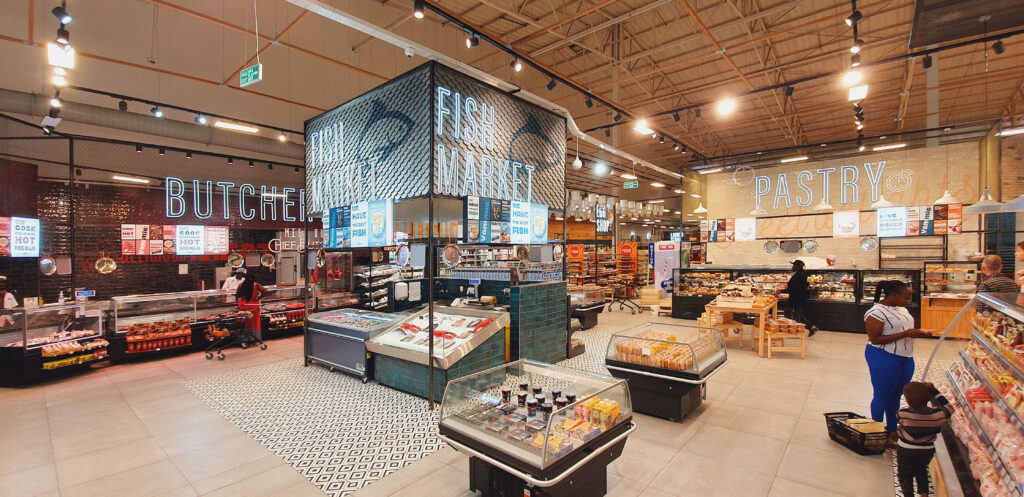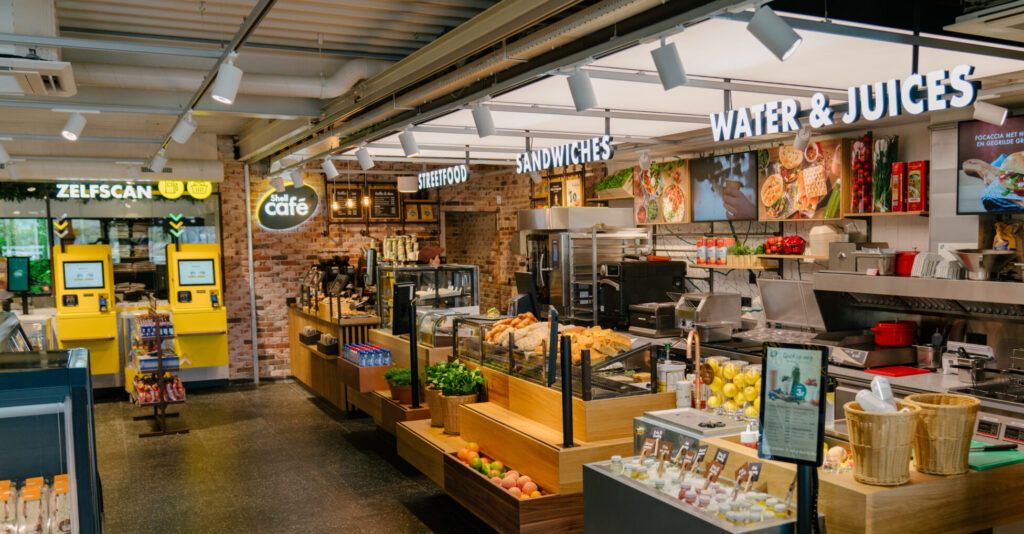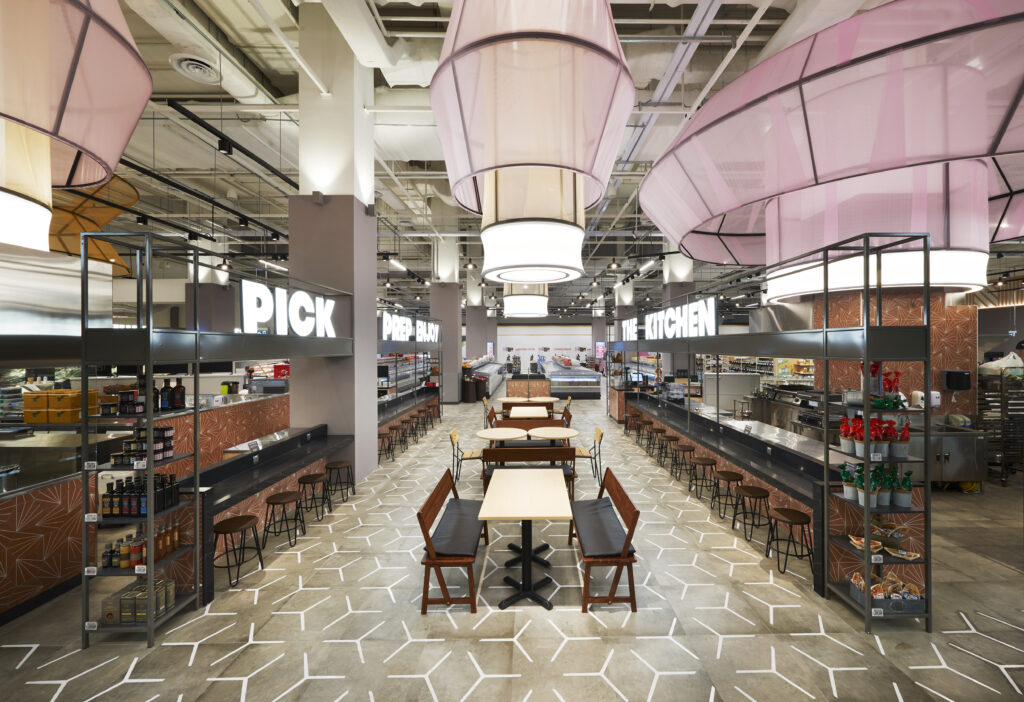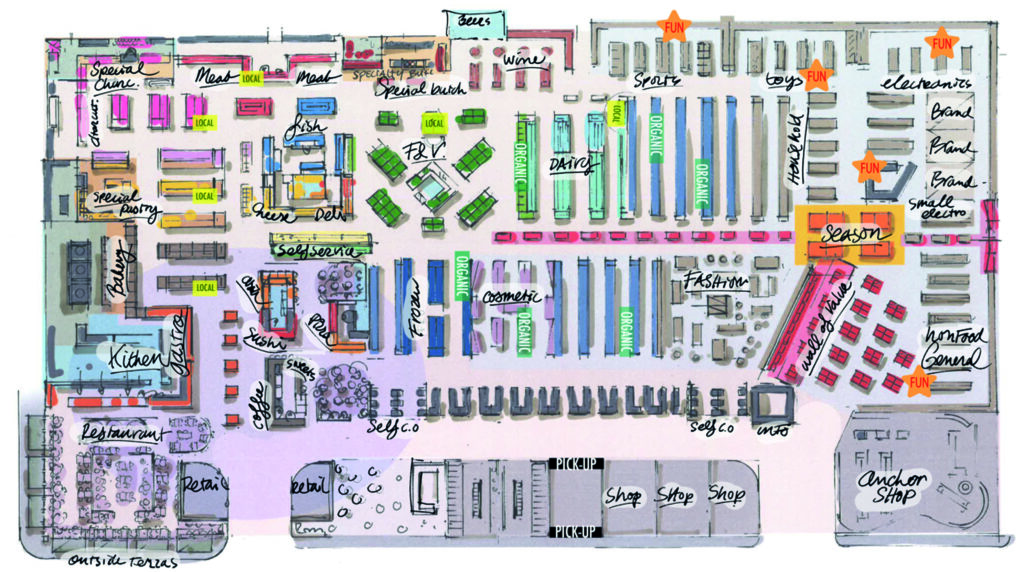
How Dutch retail designer JDV is making its mark worldwide
‘For the past 30 years, supermarket chains from all over the world have been seeking the assistance of the Dutch retail agency JDV to design their stores. Using five different examples, Christiaan and Chris Rikkers from the company in Maarssen illustrate the global trends in the industry. In the lead-up to these five examples, owner Christiaan Rikkers and his daughter and retail strategist Chris Rikkers first explain what JDV stands for in 2023. 'Originally, our positioning was 'turning creativity into success,'' says Christiaan Rikkers. 'However, nowadays, it's not just about the commercial outcome of a store design. What has become just as important is the meaning and purpose you can add to a project. Such as developing a sustainable vision. What does the store contribute to a better world?'
We want to do more than just design beautiful stores. Our goal is to balance functionality, commercial success and meaningful experience.
Chris Rikkers: ‘Consider the use of sustainable materials, thinking about good working conditions, clear in-store communication and highlighting products with a smaller ecological footprint through striking shelf presentation. We want to do more than just design beautiful stores. Our goal is to balance functionality, commercial success and meaningful experience.’
So it’s more than just designing shelves for your customers?
Chris: ‘Let me make it clearer with an example. We devise a shelf vision for manufacturers . How can you influence sales using shelf layout is the central question. You can develop beautiful products, but ultimately it has to happen on the shelf. For example, we think about ways to entice consumers to make more sustainable choices. We do this on the basis of storytelling, transparency and in-store communication .’
JDV uses the be leaf model. What’s the story behind that?
Chris: ‘It is a model with which we impose sustainability requirements on the design process based on the customer’s ambitions. From material selection, flexibility during use and ultimately how materials can be returned to the secular economy. The question we ask ourselves is: How can we ensure that the interior lasts much longer, not 3 to 5 years?’

Be-Leaf Model JDV
What global trends do you see when it comes to developing retail concepts?
Christiaan: ‘We distinguish three different markets worldwide. First, you have the traditional market. Think of the retailers in the Netherlands, Germany and Central Europe. These are the well-known retail names that we see every day. Then there is the new market, which you will find in Africa and the Middle East. If I look at Africa, developments there are moving very quickly. Much faster than in traditional markets.
The modern elements from the west are combined with special local parts and products. That makes for beautiful shops. Shops that make you think: if only we had them here in the Netherlands. In fact, you see the law of diminishing returns passing you by. Finally, we have the transition market, a mix of traditional and new. This model revolves around the alignment of the store’s economic, social and sustainable results.’
Chris: ‘This is what we call making a formula green, lean and mainstream. It’s about balancing planet and profit. Volume is an important concept to generate real impact. You achieve more if you reduce the consumption of 100 stores by 20 percent than if you renovate a few stores whose consumption has been reduced by 100 percent.’
Can you give some examples of clients where you integrate these kinds of global trends?
Christiaan: ‘Let me make it clear with five examples. The first is supermarket chain Naivas Kenya, an example from the new market. It is a Kenyan family business, currently run by the third generation. Naivas combines elements of the European and American farmer markets with the strengths of the local Kenyan market. So the combination of international retail standards with a local touch. Much in the shops is made by local companies and using local materials. From the stones, tiles to the woven baskets. Naivas has a high level of ambition. They were third or fourth in the market, but after a number of acquisitions that has changed. Naivas is, so to speak, the Jumbo of Kenya. They knocked Carrefour off first place in Kenya. The formula currently has around 100 stores. We are working on six or seven large food markets of the formula.’

Naivas Food Market, Kenya
Chris: ‘We are now also working on the next step in this new market, say the transition model. We are currently developing an idea for a bioreceptive shop in Kenya. A store that serves as an ecosystem. In that case, it is not only about whether your material is sustainable, but also whether you can use that material to create a natural habitat for animals in an urban environment, for example. That’s an idea we’re toying with right now. And everything within the local context. When it comes to energy, for example, we see opportunities for the combination of solar panels with natural ventilation.’
Christiaan: ‘The concept of which this store will be part is called Safari centre. This complex is now under construction and can be found along the road between Nairobi and the border of Uganda. It will be a kind of stopping place on the main route. The USP is that here are the cleanest toilets in the country. It will be a concept with a supermarket, a hotel and a kind of local coffee bar as components. We are responsible for the architecture, developing the concept and the shop interior. We do this in collaboration with local parties.’
Chris: ‘We like to work with local parties to develop relevant concepts that match the needs of the specific customer. Based on our Kenyan projects, we were also approached by a party from Ghana. We are now working on three major projects there. We are also active in Egypt and South Africa. Thanks to years of experience, we now have extensive knowledge of the African market. In any case, what you shouldn’t do in Africa is tell them how things should be done. You have to do it together. Because if you don’t do that, you won’t make it in Africa.’

Boon’s Markt Schets-lay-out Verswerelden
Boon’s Market
Christiaan: ‘Example two comes from our own country, Boon’s Markt. A family business where there was a change of generations when we started working together in 2015. We wanted a formula where both the heritage, the family business, and the local were the strength of the formula. Show that you have a retail concept that focuses on local, but is affordable at the same time. That is also where the idea of the slogan ‘It is possible’ (Het kan wel) came from. At the same time, emphasis was also placed on the footprint of the products, on transparency. On that point, I’m talking about 2016, Boon’s Market was a forerunner.’
Chris: ‘The formula included a responsible alternative as a promise from the start. Or healthy, or local, or sustainable. Back then we introduced a fresh arena in stores. Nowadays many formulas have that, but then this was quite new. That also applied to the splitting of the fresh and KW world, the bakery as the center.’
‘Another initiative was to create moments of happiness in the store. In the form of cross-merchandising, for example strawberries in combination with a strong communication image. On which the story and photo of the local farmer was mentioned. So, the story of local, of transparency, the story behind ‘It is possible’.
Christiaan: ‘The first store we opened is in Vlaardingen. The results immediately exceeded our expectations. Really special. Boon’s Market is reluctant to share their successes, they don’t shut it from the rooftops. The “just act normal” idea. Grow slowly, sustainably growth , it doesn’t have to be too fast. You can now see that Coop entrepreneurs are also flocking to that formula. They see that you can still run a good neighborhood supermarket with a lower turnover, while other parties are struggling to come up with the ‘better in the neighborhood’ concept.’

Shell Cafe, The Netherlands
Shell Cafe
Christiaan: ‘Shell Cafe is not a supermarket, but it is a special food concept. Shell had the question: What will our station of the future look like? All cars may eventually be electric. Then you play with the question of how to shape the transition from fuel to electricity. Soon Shell will no longer need petrol stations, but they will have special locations when it comes to traffic. What do you do with those locations if consumers don’t have to be there for fuel? This is how we came up with a modern living room concept, where people can open their laptops in peace. It must be a place where it is really pleasant to stay.’
Chris: ‘And then it’s about the word real. It must be a place with really good hospitality elements to attract customers to the cafe. So real hospitality, really good food and creating a real moment of rest. Otherwise it won’t work. It’s the step from refueling the car to refueling yourself. In a space that you should see as the place in between home and your workplace. With the furnishing of a living room.’
Christiaan: ‘It is quite difficult for a formula like Shell to take this step, to appear credible. After all, Shell has a strong petrol smell. How do you get rid of that image? Then you have to go a step further in your concept than you would normally do.’
Chris: ‘How do you ensure that people see a Shell location as a meeting place? A place where they want to stay longer? As said, everything should be fine. Very tasty sandwiches, very friendly service with a hostess, attractive coffee corner and seats, a water tap. In addition, a local touch on the wall. For example, an image of the Erasmus Bridge in Rotterdam.’
Christiaan: ‘I see the combination of electric and Shell along the highway as a very good one. I have confidence in that. In contrast to the charging station structure at supermarkets, I find that nonsensical. You can charge in the driveway at home, at work or at locations along the road. I have an electric car myself and never charge at a supermarket. I seriously wonder whether there is room for the supermarket within the loading structure.’

Fair Price, Singapore
Fair Price
Christiaan: ‘We find a real party for the consumer in Singapore. Fair Price can be seen as the ultimate shopping experience. We currently distinguish three different shopping trips. We refer to this with the terms time, money, touch .
More on that later. Fair Price is clearly a concept that revolves around the touch; the experience. At Fair Price, they are in fact shops within a shop. Experience stores with the best fresh. Lots of food service and brands that have a flagship store here. It’s a new market on 5000 m2.’
‘We see in more and more areas that the success of the hypermarket is declining and that the super store format is developing strongly in its place. In addition, proximity stores and discount stores, the two extremes, are also on the rise. Fair Price is a typical example of a superstore there. It is a local, cooperative chain, cooperatives that revolve around experience stores. We are responsible for furnishing two of those superstores. These are projects that keep us busy for six months to a year.’
Chris: ‘You could also call Fair Price a three-world shop. You have a fantastic fresh world with specialist fish, meat and produce departments, as well as non-food and dkw, and thirdly, very important, the gastronomy section. Inside Fair Price is all about the party moment. We hardly know these kinds of shops in the Netherlands. It is an amusement park for food lovers. The product is the hero here , you see that a lot.’
‘We do a lot for Fair Price. We work on the design, the concept, the clothing, the furniture, but also the lighting plan and communication. And here too, this is done in collaboration with local builders. You should see the superstores as real destination stores. We do not know that in the Netherlands. I was just talking about gastronomy. The gastronomy of this store is responsible for 30 to 40 percent of the turnover of the entire shopping center. You will eat there in the evening. The gastronomy must be of high quality, because there is a lot of competition within the shopping centre. In Europe you could compare it to a Zur Heide in Dusseldorf .’

Food wonderland Lay-out exercise
Food Wonderland
Christiaan: ‘The last example is Food Wonderland. That only exists on paper. The name says it all, it is the dream image of the perfect store. With many fresh food specialists , focused on food experience . A specialized butcher on the shop floor and a cheese farmer with its own brand in its own shop. The fresh departments are highly specialised. Foodservice is used as in-store gastronomy, with its own identity. So not as you often see in supermarkets, where the supermarket’s own fresh produce is also offered within the food service department. In Food Wonderland you really pull food service out of the supermarket.’
‘You can see here the principle I mentioned earlier – time money, touch. By time I mean efficient and fast. Lots of convenience, convenience, fresh with the perfect taste. The kitchen focuses on different eating times. Eat it, heat it and make This is already working well internationally, but not yet in the Netherlands. Eating in the store is not really a destination for us yet . The kitchens mainly produce for the moment later in the day. You can see this in meal packages, for example. They do well in the Netherlands.’ ‘Bringing food with us is still seen as ‘unhealthy’ and ‘lazy’.
Then you have money. The promotions are presented clearly, with strong signal colours. They are large presentations with a lot of volume on the top of the shelf. The touch revolves around the mix of the food hall with the traditional supermarket. Lots of experimentation, lots of specialties and lots of fresh. The in-store communication is aimed at merging the different worlds.’
In Germany, a first step towards such a Food Wonderland is taken by the formula Globus?
‘They come with the Globus Markt Halle concept. Globus is a strong regional player in the south of Germany, which is now taking its first step into the Ruhr area. It is a derivative of our idea and quite a challenge. After all, the culture in South Germany is very different from that in the Ruhr area. In the south it’s all about good food, taking your time, in the Ruhr area there is a displacement market. More competition, less destination and lower budget. So that will be really exciting.’

Safari Centre, Kenya
JDV is therefore very active internationally. How many customers do you have?
Christiaan: ‘We are currently working on about ten formulas worldwide. The average duration of a project is three months. We are active for an average of ten customers per quarter. In the past we also have worked for Albert Heijn franchisers, Jumbo, Plus and Superunie worked. And, as we mentioned: Boon’s Market. There aren’t many chains we haven’t worked for. We have been active in almost all countries. We have also done a lot in Russia, but we are now phasing that out. We had our own office in Moscow. Instead of the Russian market, we are now mainly focusing on the Middle East in that area, which is a booming market. Our strength is the combination of international know-how and local entrepreneurship. We often work for parties that arm themselves against the major international players.’
You are very busy with concepts, but how do you view today’s customer?
Chris: ‘You actually have three different shopping trips at the moment . You can also read that in our book Time, Money, Touch. One trip is time-driven, the other budget – driven and number three is about the experience. Every person has a different shopper mission at a certain time of the day. Time, budget and experience are always balanced in a unique way. We have therefore abandoned the idea of, for example, the budget customer. You may want to save 10 cents on pasta at one point and order an expensive lunch at another. Or that you spend a lot on food service. You also see this behavior a lot among students. On the one hand, they are traditionally the budget shopper, but at a certain time of the day they also buy that tasty sandwich for that high price.’
What do you see happening in the (near) future?
Christiaan: ‘The winners will be the chains that manage to maintain their pre-covid-19 ambitions in the new world of cost-cutting. The ambitions in the field of sustainability, experience and convenience. However, the reflex is now to stop innovating. In the United Kingdom, Lidl has now halved its expansion plan. Not because of the costs, but to go for quality instead of quantity. Sounds like a good move to me.’
‘Speaking of discounters, I see a special development in that area. Due to the current economic developments, you see that service supermarkets, internationally, are busy with the idea of launching their own discount concept on the market. So launching different brands within one brand, a multi playing field. We are increasingly approached for this. I immediately say that we do not think a discount brand under the same brand name is wise. You have to do that with a different name under your own umbrella.’
Chris: ‘The difference in discount before and after Covid-19 is in the image. It was the image of poor and that is now smart. As a consumer, you consciously opt for a discount. It goes from ‘should’ to ‘want’. There is now a kind of happiness in discount . They convey the message: ‘We take the hassle out of the formula to create the right price for you’. As a customer you go to a discount ‘because you are smart enough to choose the right price’. That’s the image now.’
Christiaan: ‘Look at Aldi in China, for example, the stores there look completely different than here in the Netherlands. Dark ceilings, lots of color in the shops, wooden furniture. Penny in Germany is also a good example. Lots of colorful graphics, the use of street art and a local touch. The new discounters are a bit rebellious.’
Author: Herman te Pas
Published: Aug 31, 2023 | Distrifood
For original article by Distrifood click here
